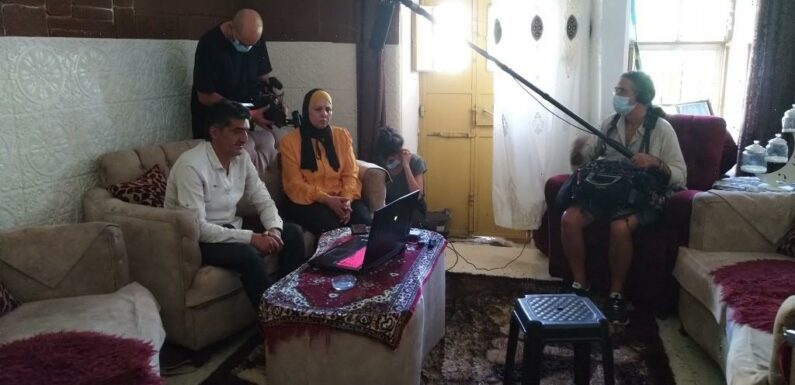
“H2: The Occupation Lab,” a documentary by Israeli filmmakers Idit Avrahami and Noam Sheizaf, chronicles the impact Jewish settlers and military occupation have had on the Palestinian city of Hebron and how the repressive methods of control there are being widely adopted in other areas of the occupied territories.
The film screens in the Zurich Film Festival’s Border Lines sidebar, which showcases works that deal with territorial and social conflicts and humanitarian issues.
Avrahami and Sheizaf had long wanted to collaborate on a project about the West Bank. “We both feel that the occupation is the most urgent issue Israeli filmmakers face,” says Sheizaf.
It was ultimately the shocking 2016 killing of a young Palestinian man by an Israeli soldier that led Avrahami and Sheizaf to focus on Hebron. A video of the incident taken by Imad Abu Shamsiya (pictured) showed the soldier, Elor Azaria, executing 21-year-old Abdel Fattah al-Sharif as he lay wounded on the street, shooting him in the head at point-blank range.
“We started thinking about this and Idit had this aha moment when she said, ‘The story is not the incident. The story is the location,’” Sheizaf recalls. “And we started digging into the history of the location, the history of the place.”
Both Sheizaf and Avrahami also have personal connections to Hebron. Sheizaf served in the city when he was an officer in the Israeli military during the 1990s, while Avrahami comes from a family that had lived in Hebron for generations.
The film focuses largely on a once bustling street in the center of Hebron that used to be lined with crowded markets and shops but is now empty, a ghost town, due to the severe security measures and division of the city that followed the Jewish settlers who have moved into the city center over decades.
“This was the heart of the city,” Sheizaf explains. “It’s a city that is very old. Hebron has existed for three to four thousand years.” The center of Hebron was comparable to the busy downtown districts of other West Asian cities, such as Cairo or Istanbul, he adds. “It was one of those places where it’s almost impossible to walk because of the merchants and the traffic and all that. There was also a central bus station in the city that had buses to Jordan, to Jerusalem, to everywhere.
“In 50 years of military control, the place has undergone a unique transformation,” Sheizaf says.
The film examines that control and its impact: how Hebron became the dystopian nightmare it is today – a city divided into two sectors, H1, controlled by the Palestinian Authority, and H2, which is under Israeli control. H2 is further divided by fences, barriers and military checkpoints that have left large parts of the Palestinian population prisoners in their own homes.
“It’s about life being sucked out of the place,” Sheizaf says. “Life was sucked out of the street and it became this political theater, where people talk about politics and fight over each meter. This process is what we wanted to show.”
Hebron is a 90-minute drive from Tel Aviv, but another world. People who visit Hebron are shocked, wondering how such a place can exist, says Avrahami. “This is the place where you see the apartheid in day-to-day life.”
“And you see it now in West Jerusalem; you see it in other parts,” she adds. “Hebron was the first place that Jews went into the Arab city and look what happened 50 years later: Arabs are behind bars, locked up, soldiers are entering their homes in the middle of the night. The same thing is happening in Jerusalem. The same thing is happening in other villages in the West Bank. So the method that was implemented in Hebron is now being used in other parts.”
In their research, the filmmakers came across troves of archive material, which they used to build the film’s narrative, Avrahami adds.
They also sought to show the occupation in a cinematic manner without being pedantic about the subject, she notes.
Indeed, Avrahami and Sheizaf stress that they were careful in the way they presented the settlers.
“We didn’t want to trivialize them; we didn’t want to humiliate them in the film like they do in some films,” Sheizaf explains. “These are people who are extremely devoted to this. But the reality is that they live under these conditions as the privileged community. If there’s a curfew, they are exempt from it. They are not under curfew. They can move freely. Living in this reality creates a lot of violence and tension.”
“We see the settlers as an arm of the state,” says Sheizaf. “As people, they are extreme, they are radicals, but they couldn’t have done it on their own. They are an arm of the state. Maybe they are an avant-garde – they step ahead, but the state catches up and agrees to what they do and helps them. If it wasn’t for the army, they wouldn’t stay.”
Avrahami and Sheizaf recently signed the petition against Israel’s Shomron Film Fund that is limited to Jewish settlers in the West Bank and inaccessible to the 2.5 million Palestinian residents of the occupied territory. “We signed the petition saying that we’re not taking grants from this fund because it’s an apartheid fund,” Sheizaf says. More than 300 filmmakers have signed the open letter.
“The occupation is a cancer,” he adds. “Everything is contaminated – everywhere you turn. It’s not just whether you know about what’s happening in Hebron. If you’re a filmmaker here in Tel Aviv you need to make those decisions.”
“H2: The Occupation Lab” is also screening in South Korea’s DMZ International Documentary Film Festival, the Antenna Documentary Film Festival in Sydney and New York’s Other Israel Film Festival.
Read More About:
Source: Read Full Article